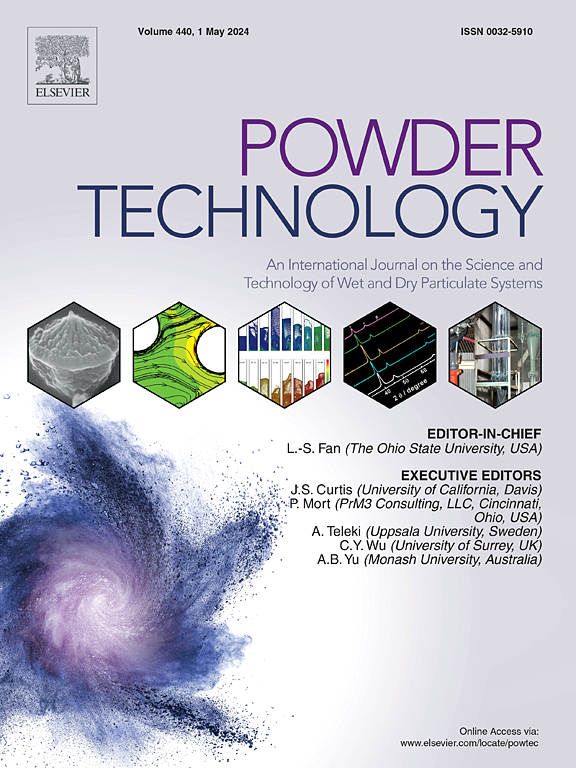Investigation on a novel mixed collector for carbon recovery from coal gasification fine slag: Experimental insight and macro molecular simulations
IF 4.6
2区 工程技术
Q2 ENGINEERING, CHEMICAL
引用次数: 0
Abstract
The effectiveness of flotation for decarbonizing fine slag from coal gasification depends on the selection of appropriate collectors or surfactants. This study explored the synergistic effect of kerosene combined with cationic surfactants, including dodecyl trimethylammonium chloride, dodecylamine, and dodecylamine hydrochloride, on recovering residual carbonaceous material from coal gasification fine slag, using both MD and experimental simulations. The Scanning electron microscopy and X-ray spectroscopy revealed that the water molecules and oxygen-rich silicon glass beads dominated the slag surface, while the XPS analysis demonstrated that the functional groups containing oxygen on the residual carbon surface promote hydrogen bonding with water molecules in the flotation solution. The results suggested that the highest yield, along with optimal Loss on Ignition (LOI) and combustible recovery, was achieved at the 10−5 mol/L surfactant concentration. The MD simulations demonstrated that dodecylamine had the highest diffusion coefficient and adsorption capacity, explaining its superior interaction with residual carbon surfaces and its effectiveness in the decarbonization process. This approach contributed to the valorization and reuse of carbon generated by the waste of coal gasification fine slag.

从煤气化细渣中回收碳的新型混合收集器研究:实验见解和宏观分子模拟
利用浮选法对煤气化产生的细渣进行脱碳的效果取决于选择适当的捕收剂或表面活性剂。本研究利用 MD 和实验模拟,探讨了煤油与阳离子表面活性剂(包括十二烷基三甲基氯化铵、十二烷基胺和十二烷基胺盐酸盐)相结合对回收煤气化细渣中残余碳质材料的协同效应。扫描电子显微镜和 X 射线光谱分析发现,水分子和富氧硅玻璃珠在炉渣表面占主导地位,而 XPS 分析表明,残炭表面的含氧官能团促进了与浮选溶液中水分子的氢键结合。结果表明,在表面活性剂浓度为 10-5 摩尔/升时,产率最高,点火损失(LOI)和可燃物回收率也最佳。MD 模拟表明,十二胺具有最高的扩散系数和吸附能力,这说明了它与残炭表面的卓越相互作用及其在脱碳过程中的有效性。这种方法有助于煤气化细渣废物产生的碳的价值化和再利用。
本文章由计算机程序翻译,如有差异,请以英文原文为准。
求助全文
约1分钟内获得全文
求助全文
来源期刊

Powder Technology
工程技术-工程:化工
CiteScore
9.90
自引率
15.40%
发文量
1047
审稿时长
46 days
期刊介绍:
Powder Technology is an International Journal on the Science and Technology of Wet and Dry Particulate Systems. Powder Technology publishes papers on all aspects of the formation of particles and their characterisation and on the study of systems containing particulate solids. No limitation is imposed on the size of the particles, which may range from nanometre scale, as in pigments or aerosols, to that of mined or quarried materials. The following list of topics is not intended to be comprehensive, but rather to indicate typical subjects which fall within the scope of the journal's interests:
Formation and synthesis of particles by precipitation and other methods.
Modification of particles by agglomeration, coating, comminution and attrition.
Characterisation of the size, shape, surface area, pore structure and strength of particles and agglomerates (including the origins and effects of inter particle forces).
Packing, failure, flow and permeability of assemblies of particles.
Particle-particle interactions and suspension rheology.
Handling and processing operations such as slurry flow, fluidization, pneumatic conveying.
Interactions between particles and their environment, including delivery of particulate products to the body.
Applications of particle technology in production of pharmaceuticals, chemicals, foods, pigments, structural, and functional materials and in environmental and energy related matters.
For materials-oriented contributions we are looking for articles revealing the effect of particle/powder characteristics (size, morphology and composition, in that order) on material performance or functionality and, ideally, comparison to any industrial standard.
 求助内容:
求助内容: 应助结果提醒方式:
应助结果提醒方式:


